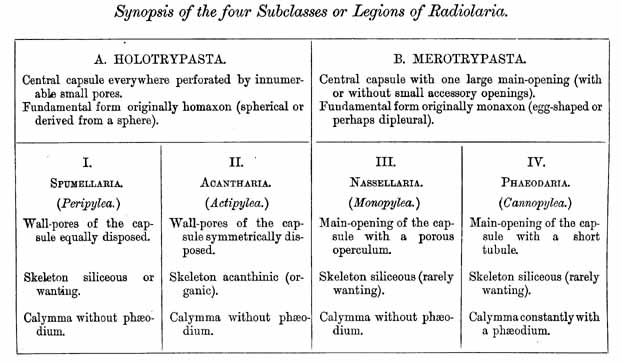
CLASS RADIOLARIA.
Radiolaria, Johannes Müller, 1858.
Rhizopoda radiaria, Johannes Müller, 1858.
Polycystina (pro parte), Ehrenberg, 1838.
Echinocystida, Claparède, 1858.
Rhizopoda capsularia, Haeckel, 1861.
Cytophora, Haeckel, 1862.
Definition of the Class: Rhizopoda with unicellular body, divided by a porous membrane into an internal or intracapsular part (with nucleus), and an external or extracapsular part (with calymma); propagating by flagellated spores.
The RADIOLARIA or CAPSULATE RHIZOPODA, first constituted by Johannes Müller in the year 1858 as a separate group of the Rhizopoda, form a peculiar class of the PROTISTA, or unicellular organisms. This class is exclusively marine, and has in general the characteristic organisation of the Rhizopoda, with the development of numerous pseudopodia from the surface of the cell; but it differs from all other Rhizopoda in the possession of a peculiar membrane, dividing the cell-body into two different parts; the central capsule or the internal part with the nucleus, and the external part or extracapsulum with the calymma; propagation by flagellated spores produced in the central capsule; the sarcode or the protoplasm of both parts communicates by fine pores, piercing the separating membrane, which is called the capsule-membrane.
The Central Capsule or the inner part of the Radiolarian body is constantly composed of three essential parts, viz. :—
The Endoplasm or "endosarc," or "intracapsular protoplasm" or "inner sarcode," in all Radiolaria originally fills that space within the capsule, which is not taken up by the nucleus. It seems to be employed mainly for the purpose of propagation, becoming divided earlier or later into numerous small particles, each of which surrounds a small particle of the nucleus and forms together with it a flagellate-spore. Besides this the endoplasm of the Radiolaria seems to have a great significance for the nutrition, mainly for the interchange of materials. It becomes very often vacuolate or alveolate, filled with smaller or larger spherical drops of fluid; it produces very commonly smaller fat granules or larger oil-globules, and further pigment-granules of different colours, more rarely crystals and other peculiar enclosed parts.
The Membrane or " capsule-membrane" is the most typical and characteristic part of the body of a Radiolarian, sufficient or itself to separate this class from all other Rhizopoda. At the same time, by its different shape it presents the best means for the systematic distinction of the four subclasses or "legions" of the class. The membrane is composed of a special organic matter (probably nearly related to chitin) and combines density with elasticity to a high degree. Observed with a high power of the microscope its margin (or section) appears commonly simple-edged, but often in larger forms distinctly double-edged.
The legion PHAEODARIA is distinguished by a double membrane (the thinner inner and thicker outer membranes being separated by an interval); in the three other legions it is simple. The membrane completely separates the intracapsular from the extracapsular body, both communicating only by certain pores or openings in the membrane. With reference to this important communication, the whole class can be divided into two subclasses, Holotrypasta and Merotrypasta: the HOLOTRYPASTA contain the Peripylea and Actipylea, in which the membrane is pierced by innumerable very small pores; the MEROTRYPASTA consist of the Monopylea and the Cannopylea, in which the membrane exhibits only one large main opening, distinguished in the former by a peculiar "porous area," in the latter by an "osculum" or a prolonged tubule.
The Calymma or "jelly-veil" is the most characteristic part of the extracapsular body in all Radiolaria; in the majority of the class it is the most voluminous part of the whole body, being much more voluminous than all the other parts taken together. The calymma is a structureless, clear, and transparent jelly-envelope, which always includes the whole central capsule and often also the whole extracapsular skeleton. Owing to the high degree of its consistence, this jelly-veil takes a very important part in the formation of the extracapsular skeleton, furnishing the matrix for the deposition of its tangential parts.
The Matrix or the "maternal tissue of the pseudopodia" is formed in all Radiolaria by the thin layer of exoplasm or of extracapsular sarcode, which immediately envelops the central capsule and is itself enclosed by the calymma. This continuous sarcode cover of the capsule communicates by its pores or openings with the endoplasm or the intracapsular sarcode; whilst from its outer surface arise the pseudopodia. The morphological signification of the matrix is very small, but the physiological importance is very great, for it seems to be the chief organ of many vital functions.
The Pseudopodia or the very fine, long, thread-like filaments of exoplasm arise in all Radiolaria in very great numbers from the surface of the matrix, and exhibit in general the same characteristic shape as in the other Rhizopoda. Their inner or proximal part is enclosed within the jelly-veil or calymma, whilst their outer or distal part floats freely in the sea-water. Their special motions and modifications exhibit considerable variations in different groups, their tendency to ramify, anastomose, and form networks being in some cases very small, in others very great. Also the characteristic motion of granules in the pseudopodia is very different. In general those most important exoplasmatic filaments serve as organs both for the vegetative functions of nutrition, and for the animal func tions of motion and sensation.
The class Radiolaria can be divided according to its varying
structure into four different legions or subclasses, the characters of
which are the following :—
I. PERIPYLEA or SPUMELLARIA.
II. ACTIPYLEA or ACANTHARIA.
III. MONOPYLEA or NASSELLARIA.
IV. CANNOPYLEA or PHAEODARIA.
 |